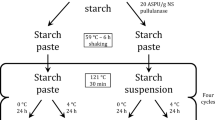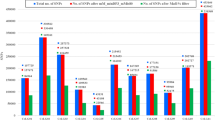Abstract
Eating quality (EQ) of rice is mainly determined by sensory evaluation using tasting, which is affected by the taster’s geographic residential area, gender, and age. The sensory evaluation protocol also requires rice samples (usually > 500 g) larger than the amount harvested from the early generations of breeding in many cases, thereby hindering the sensory tasting practices. The characteristics of rice starch have a significant impact on EQ; however, information on starch assisted-selection of EQ is insufficient. In this study, the recombinant inbred lines and backcross recombinant inbred lines constructed by the hybridization of japonica (O. sativa L. ssp. japonica) rice (cv. Toyonishiki) and indica (O. sativa L. ssp. indica) rice (cv. Qishanzhan) were used as test materials to analyze and explore the relationships between the amylose content (AC), rapid visco analyzer (RVA) profile characteristics, and the EQ score obtained from sensory tasting assessment. We provided a feasible solution to use rice starch properties to assist in selection of EQ. The results indicated that AC and RVA profile characteristics including trough viscosity (TV), final viscosity (FV), breakdown (BD), and setback (SB) were closely related to the EQ values. Furthermore, an integrated indicator—i.e., starch properties quality (SPQ)—that represented a more comprehensive characterization of rice starch, was derived based on the EQ evaluation hierarchy and weighted AC, TV, FV, BD, and SB values. The correlation between SPQ and EQ was significant (p < 0.001), and was significantly higher compared with using individual indicators. Moreover, the SPQ method requires less rice samples (i.e., 3 g of milled rice flour) and can be applied to assisted-selection for EQ in early generations of breeding. This study provid esessential technical support for the rapid and accurate identification of the EQ of progeny of indica–japonica hybrids.






Similar content being viewed by others
Abbreviations
- EQ:
-
Eating quality
- RILs:
-
Recombinant inbred lines
- BILs:
-
Backcross recombinant inbred lines
- AC:
-
Amylose content
- RVA:
-
Rapid viscoanalyzer
- TV:
-
Trough viscosity
- FV:
-
Final viscosity
- BD:
-
Breakdown
- SB:
-
Setback
- RVU:
-
Rapid visco units
- SPQ:
-
Starch properties quality
- TSI:
-
Toyonishiki
- QSZ:
-
Qishanzhan
- PV:
-
Peck viscosity
- CO:
-
Consistency
References
Ashikari M, Matsuoka M (2006) Identification, isolation and pyramiding of quantitative trait loci for rice breeding. Trends Plant Sci 11:344–350
Biselli C, Cavalluzzo D, Perrini R, Gianinetti A, Bagnaresi P, Urso S, Orasen G, Desiderio F, Lupotto E, Cattivelli L, Vale G (2014) Improvement of marker-based predictability of Apparent Amylose Content in japonica rice through GBSSI allele mining. Rice 7:1
Butardo VM, Fitzgerald MA, Bird AR, Gidley MJ, Flanagan BM, Larroque O, Resurreccion AP, Laidlaw HK, Jobling SA, Morell MK, Rahman S (2011) Impact of down-regulation of starch branching enzyme IIb in rice by artificial microRNA- and hairpin RNA-mediated RNA silencing. J Exp Bot 62:4927–4941
Devraj L, Natarajan V, Vadakkeppulpara Ramachandran S, Manicakam L, Sarvanan S (2020) Influence of microwave heating as accelerated aging on physicochemical, texture, pasting properties, and microstructure in brown rice of selected Indian rice varieties. J Texture Stud 51:663–679
Jin Q, Xu X (2020) Microstructure, gelatinization and pasting properties of rice starch under acid and heat treatments. Int J Biol Macromol 149:1098–1108
Kinoshita N, Kato M, Koyasaki K, Kawashima T, Nishimura T, Hirayama Y, Takamure I, Sato T, Kato K (2017) Identification of quantitative trait loci for rice grain quality and yield-related traits in two closely related Oryza sativa L. subsp. japonica cultivars grown near the northernmost limit for rice paddy cultivation. Breed Sci 67:191–206
Lee H, Kim HS (2020) Pasting and paste properties of waxy rice starch as affected by hydroxypropyl methylcellulose and its viscosity. Int J Biol Macromol 153:1202–1210
Lestari P, Ham TH, Lee HH, Woo MO, Jiang W, Chu SH, Kwon SW, Ma K, Lee JH, Cho YC, Koh HJ (2009) PCR marker-based evaluation of the eating quality of japonica rice ( Oryza sativa L.). J Agric Food Chem 57:2754–2762
Loubes MA, Gonzalez LC, Tolaba MP (2018) Pasting behaviour of high impact ball milled rice flours and its correlation with the starch structure. J Food Sci Technol 55:2985–2993
Luo J, Jobling SA, Millar A, Morell MK, Li Z (2015) Allelic effects on starch structure and properties of six starch biosynthetic genes in a rice recombinant inbred line population. Rice 8:15
Nakamura S, Katsura J, Kato K, Ohtsubo K (2016) Development of formulae for estimating amylose content and resistant starch content based on the pasting properties measured by RVA of Japonica polished rice and starch. Biosci Biotechnol Biochem 80:329–340
Sandhu RS, Singh N, Kaler RSS, Kaur A, Shevkani K (2018) Effect of degree of milling on physicochemical, structural, pasting and cooking properties of short and long grain Indica rice cultivars. Food Chem 260:231–238
Sato Y, Nishio T (2003) Mutation detection in rice waxy mutants by PCR-RF-SSCP. Theor Appl Genet 107:560–567
Su Y, Rao Y, Hu S, Yang Y, Gao Z, Zhang G, Liu J, Hu J, Yan M, Dong G, Zhu L, Guo L, Qian Q, Zeng D (2011) Map-based cloning proves qGC-6, a major QTL for gel consistency of japonica/indica cross, responds by Waxy in rice (Oryza sativa L.). Theor Appl Genet 123:859–867
Sun J, Liu D, Wang JY, Ma DR, Tang L, Gao H, Xu ZJ, Chen WF (2012) The contribution of intersubspecific hybridization to the breeding of super-high-yielding japonica rice in northeast China. Theor Appl Genet 125:1149–1157
Sun MM, Abdula SE, Lee HJ, Cho YC, Han LZ, Koh HJ, Cho YG (2011) Molecular aspect of good eating quality formation in japonica rice. PLoS ONE 6:e18385
Thanyasiriwat T, Sraphet S, Whankaew S, Boonseng O, Bao J, Lightfoot DA, Tangphatsornruang S, Triwitayakorn K (2014) Quantitative trait loci and candidate genes associated with starch pasting viscosity characteristics in cassava (Manihot esculenta Crantz). Plant Biol 16:197–207
Tian Z, Qian Q, Liu Q, Yan M, Liu X, Yan C, Liu G, Gao Z, Tang S, Zeng D, Wang Y, Yu J, Gu M, Li J (2009) Allelic diversities in rice starch biosynthesis lead to a diverse array of rice eating and cooking qualities. Proc Natl Acad Sci 106:21760–21765
Tong C et al (2014) Genetic diversity of amylose content and RVA pasting parameters in 20 rice accessions grown in Hainan, China. Food Chem 161:239–245
Wan XY, Wan JM, Su CC, Wang CM, Shen WB, Li JM, Wang HL, Jiang L, Liu SJ, Chen LM, Yasui H, Yoshimura A (2004) QTL detection for eating quality of cooked rice in a population of chromosome segment substitution lines. Theor Appl Genet 110:71–79
Wang H, Xiao N, Ding J, Zhang Y, Liu X, Zhang H (2020) Effect of germination temperature on hierarchical structures of starch from brown rice and their relation to pasting properties. Int J Biol Macromol 147:965–972
Wu P, Li C, Bai Y, Yu S, Zhang X (2019) A starch molecular basis for aging-induced changes in pasting and textural properties of waxy rice. Food Chem 284:270–278
Yamanaka S, Nakamura I, Watanabe KN, Sato Y (2004) Identification of SNPs in the waxy gene among glutinous rice cultivars and their evolutionary significance during the domestication process of rice. Theor Appl Genet 108:1200–1204
Zhou H, Wang L, Liu G, Meng X, Jing Y, Shu X, Kong X, Sun J, Yu H, Smith SM, Wu D, Li J (2016) Critical roles of soluble starch synthase SSIIIa and granule-bound starch synthase Waxy in synthesizing resistant starch in rice. Proc Natl Acad Sci 113:12844–12849
Zhu L, Zhang Y, Wu G, Qi X, Dag D, Kong F, Zhang H (2020) Characteristics of pasting properties and morphology changes of rice starch and flour under different heating modes. Int J Biol Macromol 149:246–255
Funding
This research was funded by Science Foundation of Liaoning Province (2019-ZD-0397), PhD research startup foundation of Liaoning Province (2020-BS-300), Science Foundation of Liaoning Academy of Agricultural Sciences (2019-QN-08), and Science Foundation of Liaoning Academy of Agricultural Sciences (2020-QN-2416).
Author information
Authors and Affiliations
Contributions
All authors had read and approved the final version of the manuscript. TM and ZZ designed the research; SJN, YZZ, XL and LLZ performed the field planting; YL and SCZ performed part of the quality analysis; HH and SLW provided the rice materials used in this study; XL wrote the paper.
Corresponding author
Ethics declarations
Conflicts of interest
The authors declare that they have no conflict of interest.
Additional information
Publisher's Note
Springer Nature remains neutral with regard to jurisdictional claims in published maps and institutional affiliations.
Rights and permissions
About this article
Cite this article
Mao, T., Zhang, Z., Ni, S.J. et al. Assisted selection of eating quality progeny of indica (O. sativa L. ssp. indica) and japonica (O. sativa L. ssp. japonica) hybrids using rice starch properties. Genet Resour Crop Evol 68, 411–420 (2021). https://doi.org/10.1007/s10722-020-01044-w
Received:
Accepted:
Published:
Issue Date:
DOI: https://doi.org/10.1007/s10722-020-01044-w




